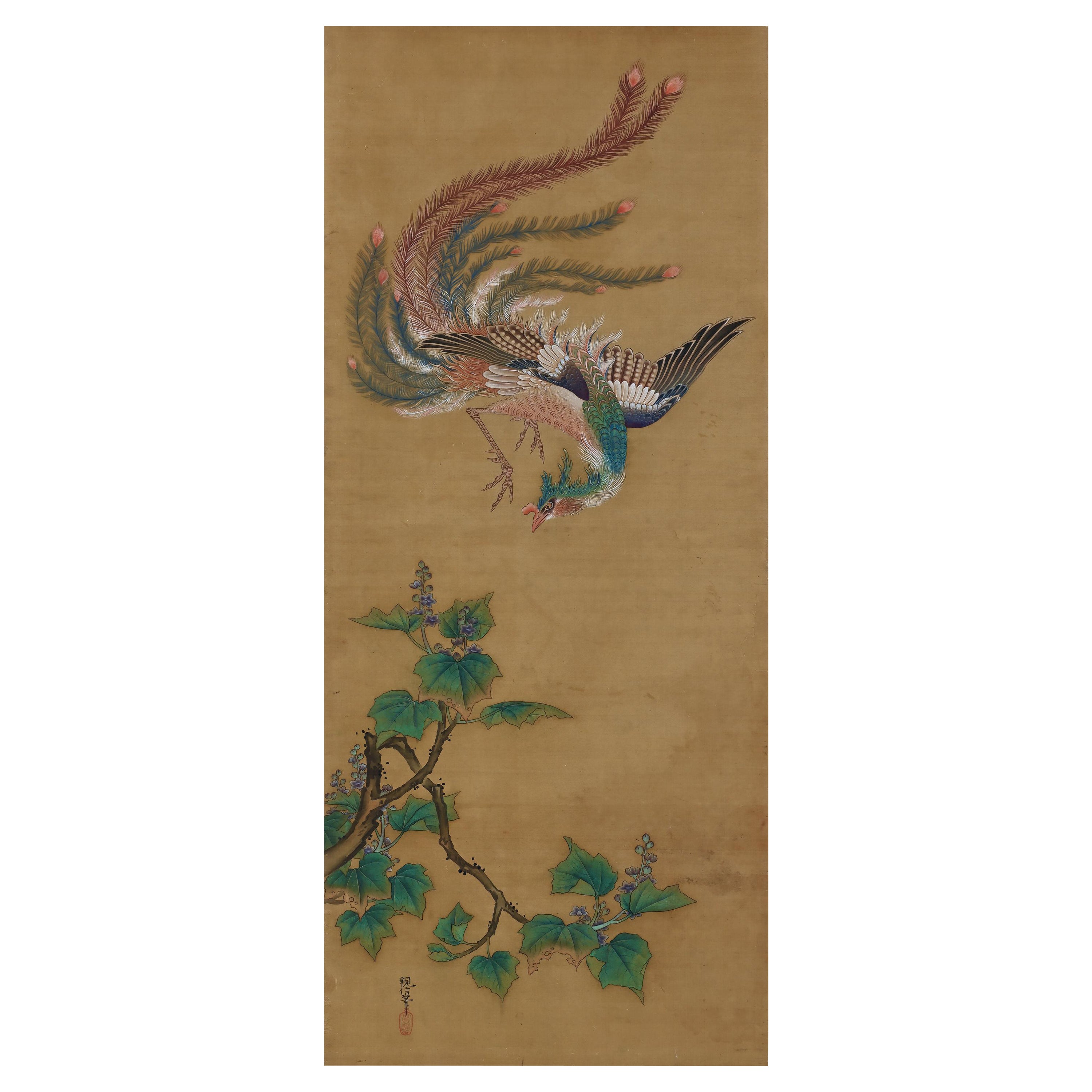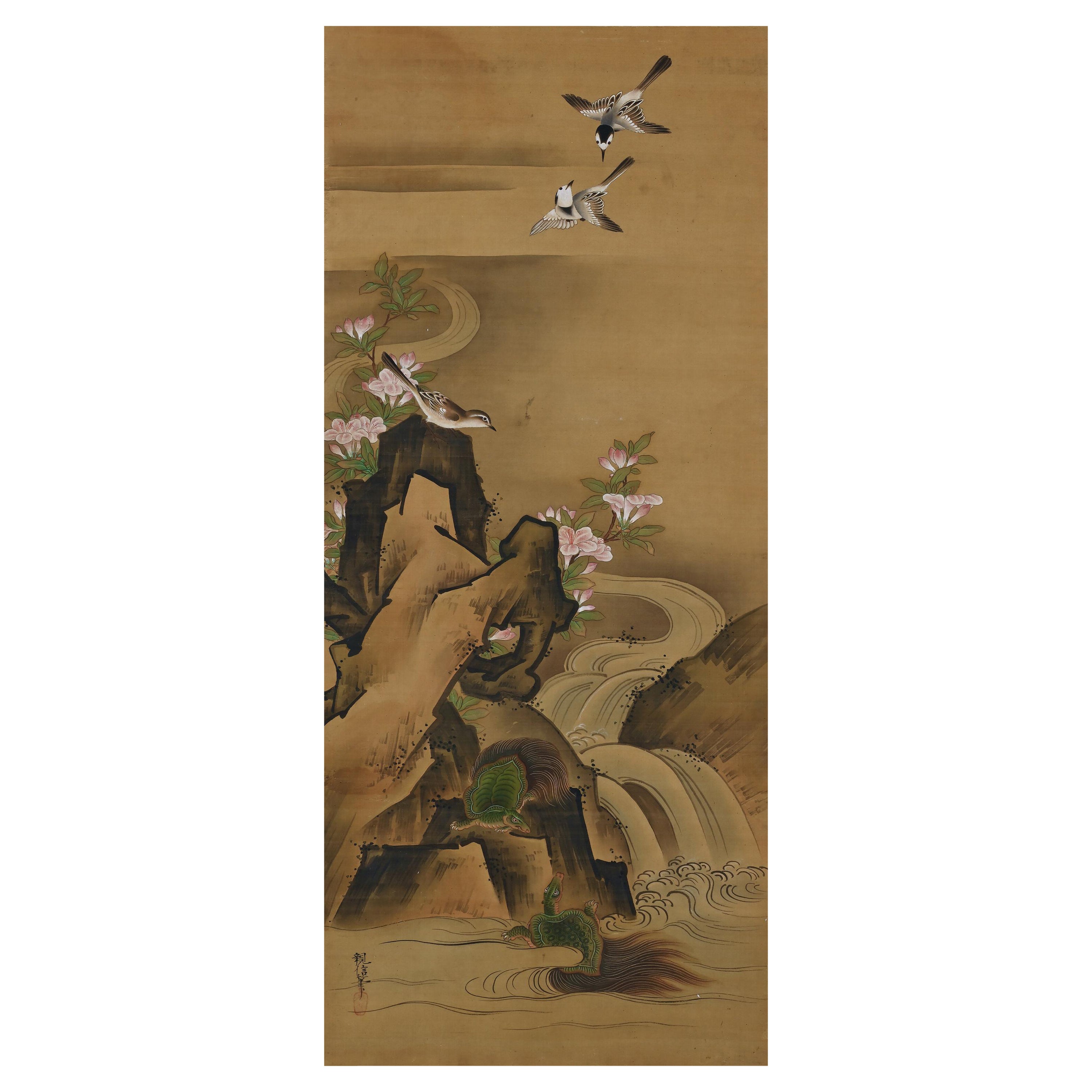Items Similar to 19th Century Japanese Silk Painting by Kano Chikanobu, Crane, Pine & Camelia
Want more images or videos?
Request additional images or videos from the seller
1 of 7
19th Century Japanese Silk Painting by Kano Chikanobu, Crane, Pine & Camelia
About the Item
Birds & Flowers of the Seasons
Pheasants & Plum in Snow
Unframed painting. Ink, pigment and gofun on silk
Kano Chikanobu 1819-1888
Signature: Chikanobu
Seal: Shateki
Offered here is an unframed ‘kacho-e’ painting by the 19th century Japanese Takamatsu domain painter Kano Chikanobu. There are 8 individual paintings available, which originally would have been part of a set of 12. ‘Kacho-e’ literally means ‘pictures of birds and flowers’. In reality it covers a wide range of natural motifs including birds, fish, insects and small animals in combination with flowers, grasses or trees. The theme has a long history in Japanese painting. It is one of three painting genres, the other two being landscape and figure, which derive from Chinese academic painting classification. As one of the accepted types of painting to be shown in official residences, scenes of birds, flowers and animals were rife with metaphorical reference as well as physical beauty.
In these paintings Chikanobu has made conspicuous use of brilliant pigments and meticulous brushwork. The rocks, water, trees, blossoms, and birds are treated as stylized formal elements in a grand design. All of the components contribute to the patterned effect and tactile richness of the surface. Beyond their highly decorative qualities, the subject of some of the paintings are also an allusion to imperial allegiance; the pheasants are symbolic of bravery and steadfastness, peacocks represent divinity and power, and the phoenix paired with paulownia a just and benevolent ruler. Cranes and turtles symbolize longevity, and the lush, full bloom of the peony flower represents wealth and opulence. Paintings of native Japanese birds and flowers were appreciated primarily for their evocation of the seasons and the traditional poetic emotions associated with them. This is the case with the spring scene of cherry blossoms and birds and the winter scene of narcissus, nandina and sparrows. The rich expression of flower and bird paintings opens our eyes not only to the beauty of the creations of nature, but also to the underlying feelings and emotions of people who cherished this genre of painting in the mid 19th century.
The artist, Kano Chikanobu, was the last official hereditory painter for the Takamatsu feudal domain (present day Kagawa Prefecture). It was his primary duty to supply paintings for his feudal lord. The domain was disbanded in 1871 but not before they fought against the reformist forces at the onset of the Meiji Restoration in 1868. It was a turbulent time in history and the Takamatsu strived unsuccessfully to retain their centuries old way of life.
The paintings have recently been restored in Kyoto utilizing traditional materials and techniques. Fresh backing papers have been applied to the silk in preparation for presentation in a western style frame. Amongst the work carried out during restoration was the cleaning of water damage, repair of holes with replacement silk, reinforcement of cracked silk and touch-ups of the background. There has been no re-painting of the images.
- Dimensions:Height: 46.25 in (117.48 cm)Width: 19.5 in (49.53 cm)Depth: 0.01 in (0.26 mm)
- Style:Edo (Of the Period)
- Materials and Techniques:
- Place of Origin:
- Period:
- Date of Manufacture:circa 1850
- Condition:Repaired: Recently restored in Kyoto. Traditional craftsmen and techniques. Work included washing, stain removal, repair of damages with replacement silk and reinforcement of cracked silk. The paintings are ready to be presented in a western style frame. Wear consistent with age and use.
- Seller Location:Kyoto, JP
- Reference Number:1stDibs: LU2472325348842
About the Seller
5.0
Recognized Seller
These prestigious sellers are industry leaders and represent the highest echelon for item quality and design.
Gold Seller
These expertly vetted sellers are highly rated and consistently exceed customer expectations.
Established in 2001
1stDibs seller since 2016
62 sales on 1stDibs
Typical response time: 6 hours
- ShippingRetrieving quote...Ships From: Kyoto, Japan
- Return PolicyA return for this item may be initiated within 10 days of delivery.
More From This SellerView All
- 19th Century Japanese Silk Painting by Kano Chikanobu, Phoenix & PaulowniaLocated in Kyoto, JPBirds & Flowers of the seasons Pheasants & Plum in Snow Unframed painting. Ink, pigment and gofun on silk Kano Chikanobu 1819-1888 Signature...Category
Antique Mid-19th Century Asian Edo Paintings and Screens
MaterialsSilk
- 19th Century Japanese Silk Painting by Kano Chikanobu, Turtles & AzaleaLocated in Kyoto, JPBirds & flowers of the seasons Pheasants & plum in snow Unframed painting. Ink, pigment and gofun on silk Kano Chikanobu 1819-1888 Signature...Category
Antique Mid-19th Century Asian Edo Paintings and Screens
MaterialsSilk
- Circa 1700 Japanese Screen Pair, Cranes & Pines, Kyoto Kano SchoolLocated in Kyoto, JPPines and Cranes Anonymous. Kyoto Kano School. Late 17th/early 18th centuries, circa 1700. Pair of six-panel Japanese folding screens. Ink, gofun, pigment and gold leaf on paper. This bold composition presents two pine trees extending to the left and right across a gold leaf background. One tree is silhouetted against a green ground, golden clouds obscuring its true size, the other stretches across a stylized waterway. The pines are paired with Manchurian cranes with red crests and snow white plumage. Both have been highly auspicious motifs in East Asia since Chinese antiquity. Here the artist utilized fluid and instinctive ink brushstrokes to define the trunk, branches and tail feathers, in strong contrast to the precision and sharp angularity of the crane’s legs and beaks. The adoption of this vast metallic painting support required an unerring sense of design and composition, so that the negative space surrounding motifs could imply context for the otherwise floating pictorial elements. The brushwork detailing the trunks of the pines, the exaggerated dimensions of the pine trees and the strength and dynamism of the composition are all reminiscent of Kano Eitoku...Category
Antique Late 17th Century Japanese Edo Paintings and Screens
MaterialsGold Leaf
- 17th Century Japanese Framed Painting by Kano Sansetsu, Plum Blossoms in SnowLocated in Kyoto, JPKano Sansetsu (1589-1651) Plum blossoms in snow Edo period, circa 1640 Framed painting. Ink on paper. Kano Sansetsu is a Japanese painter who...Category
Antique 17th Century Japanese Edo Paintings and Screens
MaterialsPaper
- Japanese Screen Painting, circa 1700 'Horses' by Kano TanshinLocated in Kyoto, JPHorses Kano Tanshin Morimasa (1653-1718) Two-panel tea-ceremony Japanese screen or furosaki Ink on gold leaf, late 17th-early 18th century Measures: H 55 cm x W 182 cm The Kano school was closely aligned with the warrior class in Japan. The samurai, who lived in a closed and rigid hierarchical society established by the Shogunate, were drawn to the energy and freedom horses symbolize; Kano school artists commonly depicted the equine creatures as they are here, in unfettered and carefree family groups. China originally introduced horse paintings to Japan; the works typically focused on capturing the essence of horses in their various environments and often involved integrating human figures into the images. Kano Tanshin Morimasa (1653-1718) was the son of Kano Tanyu...Category
Antique 1690s Japanese Edo Paintings and Screens
MaterialsGold Leaf
- 19th Century Japanese Scroll Painting by Igarashi Chikusa, Poppies & ButterfliesLocated in Kyoto, JPPoppies & Butterflies Ink, pigment and gofun on silk Igarashi Chikusa (1774-1844) Signature: Chikusa Ran Zen Upper Seal: Ran Shuzen Lower Seal: Kyoho Dimensions: Scroll: H. 68” x W. 18” (172cm x 45cm) Image: H. 38.5’’ x W. 12.5’’ (98cm x 32cm) This composition shows elegant images of poppies and the butterflies that are inevitably drawn to them. It captures a momentary glimpse into a world both visually dazzling and startlingly realistic. The painting is infused with sensitivity and attention to seasonal change and weather conditions. The thin and fragile poppies are beautifully depicted with brilliant colors and the butterflies are similarly infused with life. The painting is on silk which requires extremely precise painting skills as no element once painted can be removed. Poppies were a favorite subject of Rinpa school artists through the ages. Originally they were somewhat abstracted but by the age of Sakai Hoitsu...Category
Antique Early 19th Century Japanese Edo Paintings and Screens
MaterialsSilk
You May Also Like
- 19th Century Japanese Edo Six Panel Kano School Landscape ScreenLocated in Rio Vista, CALate Edo period 19th century Japanese six-panel landscape screen featuring a cypress tree over a flowering hibiscus with a pair of hototogisu birds. Kano school painted with ink and ...Category
Antique 19th Century Japanese Edo Paintings and Screens
MaterialsSilk, Wood, Paper
- Antique Japanese Six-Panel Screen by Kano ChikanobuLocated in Prahran, VictoriaLate 17th century Kano school peony landscape screens. One of a pair of screens signed: Hogan Josen Fujiwara Chikanobu Hitsu - Kano Chikanobu (Shushin) ...Category
Antique Early 18th Century Japanese Edo Paintings and Screens
MaterialsGold Leaf
- Japanese Antique Ink Painting / 19th Century / Rare Chinese Character PaintingLocated in Sammu-shi, ChibaWe have a unique Japanese aesthetic sense. And only we can introduce unique items through our purchasing channels in Japan and the experience we have gained so far, in such a way that no one else can imitate. It is an ink painting written after the Meiji era. The biggest attraction of this work is that it uses Chinese characters to create paintings. To explain in detail, it is written here in Chinese characters as "un-ryu" . "Un" is a cloud and "ryu" is a dragon. These are embodied and drawn by comparing them to the meaning of Chinese characters. And the clouds depict the clouds hanging over the mountain, and the dragon depicts the climbing toward the mountain. Humorous paintings...Category
Antique Late 19th Century Japanese Edo Paintings
MaterialsAcrylic, Paper
- Antique Japanese Six-Panel Screen by Kano Chikanobu "Shushin"Located in Prahran, VictoriaLate 17th century Kano school peony landscape screens. Both screens signed: Hogan Josen Fujiwara Chikanobu Hitsu - Kano Chikanobu (Shushin) (1660 - 1728...Category
Antique Early 18th Century Japanese Edo Paintings and Screens
MaterialsGold Leaf
- 18th Century Japanese Kano School Landscape ScreenLocated in Prahran, VictoriaJapanese Kano school screen with pine tree, camellias, cherry blossom and Chinese figures in the landscape, circa 18th century. Materials: Pigmen...Category
Antique 18th Century Japanese Paintings and Screens
MaterialsSilver Leaf
- 19th Century Japanese Edo Screen Kano School Garden TerraceLocated in Rio Vista, CAFantastic 19th century Japanese Edo/Tokugawa period two-panel byobu screen featuring Chinese children frolicking on a garden terrace with a pavilion and large pine tree. Made in the ...Category
Antique 19th Century Japanese Edo Paintings and Screens
MaterialsBrass, Gold Leaf
Recently Viewed
View AllMore Ways To Browse
Antique Silk Paintings
Japanese Painting 19th
19th Century Japanese Paintings
Japanese Silk Painting
Silk Pictures
Antique Painting On Silk
Asian Silk Art Painting
Watered Silk
Antique Japanese Silk
Mid Century Asian Painting
Japanese Paintings On Silk
Silk Painting Japan
Asian Silk Screens And Paintings
Silk Screen Paintings
Japanese Painted Silk
Asian Midcentury Artist
Pines Japanese
Antique Japanese Silk Art





